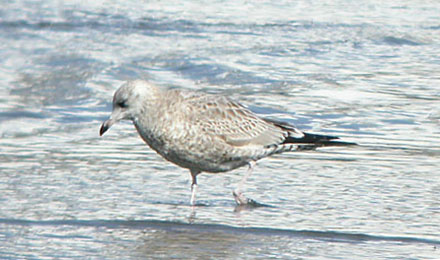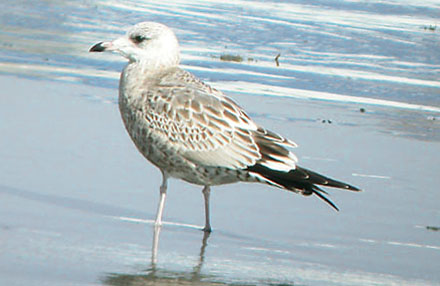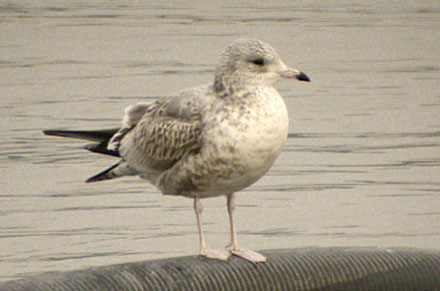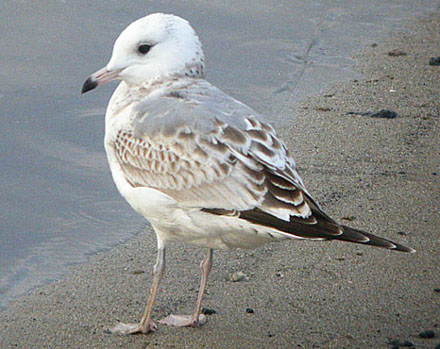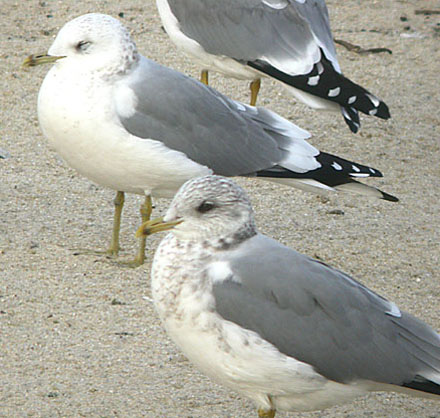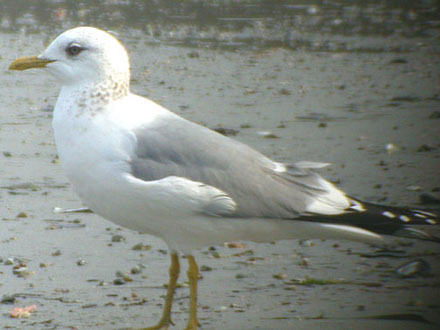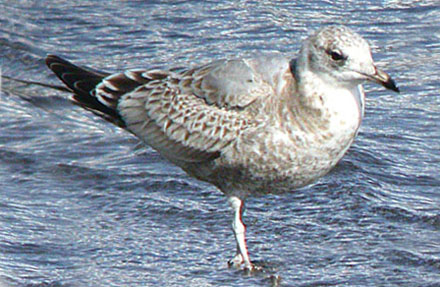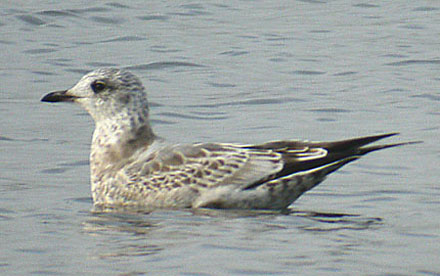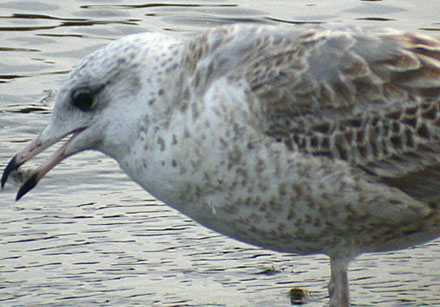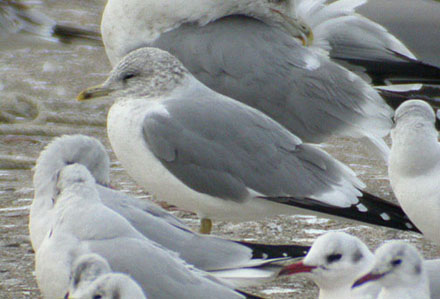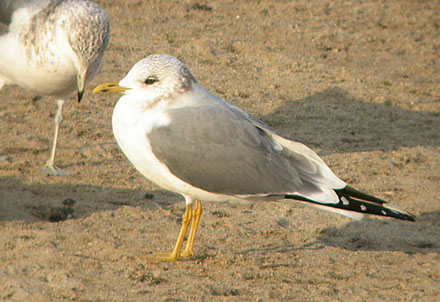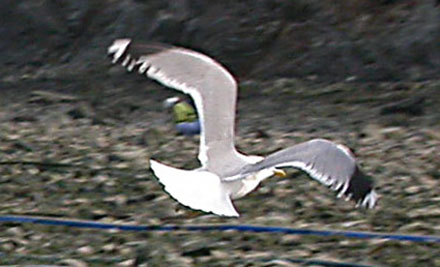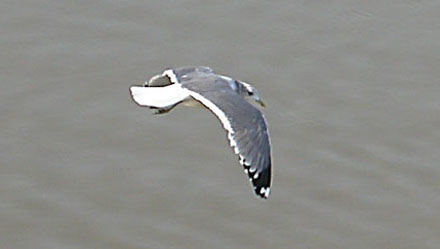Introduction
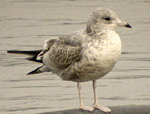
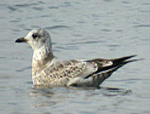
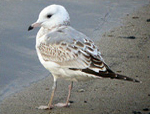
Malling Olsen and Larsson (2003) (from hereon “Gulls”) separate Mew Gull Larus brachyrhynchus off from Common Gull Larus canus, and report of Kamchatka Gull L.c. kamtschatschensis that it is a “distinct (the largest) taxon, probably requiring fully specific status”. Interest in looking at Common Gulls has surely been greatly increased by such statements, and perhaps partly as a result several gulls in Western Europe (and the US) have generated much recent discussion.
This note, with 13 accompanying images (scroll to bottom of page), has therefore been written largely in response to questions mailed to Birds Korea about two such "Common-type Gulls" seen in late 2004, one on the Scilly Isles and one on the Isle of Man, both in northwestern Europe.
The purpose of this note is not to suggest the identification of either individual; nor is it to propose (strongly) an opinion on the status of Kamchatka Gull; nor is it to provide some simple diagnostic features that will prove the identity of an extralimital taxon.
It is simply much more to stress how great the variation is in Common Gull found in Far East Asia, and to suggest that before claims of heinei or especially kamtschatschensis are made, it seems at first necessary to establish much more clearly:
the typical appearance of individuals considered to be nominate canus, heinei and kamtschatschensis (and brachyrhynchus); and
to clearly identify the predictable limits of each taxon's variability.
This note and its opinions are based on 14 years of gull-watching in Japan (1990-1998) and South Korea (1998-present), with many thousands of Common Gull seen in all months in Far East Asia between October and April (with e.g. ca 2 500 on Dec 18th 2004). It is also based on some familiarity with nominate canus in Western Europe, and to a much lesser extent with brachyrhynchus, following several birding trips to the western US and Canada.
Limits To Knowledge
In short, although I have tried to invest significant time in field study (along with many others, perhaps most notably the Ujiharas in Japan and other visiting gullers such as Jon King and Geoff Carey), I personally feel that not enough is yet known about kamtschatschensis and heinei to try to delineate hard-and-fast identification criteria for them.
Other much more specialized and experienced gullers might well disagree with such an observation (and it would seem appropriate to learn both from where their confidence is derived, and also their conclusions).
In general, Common Gull in Japan and Korea are larger and darker-saddled as adults, and paler-eyed and longer-billed than nominate Common Gull in Western Europe. Many individuals look more powerfully built, rather closer to Ring-billed Gull Larus delawarensis (with much overlap in bill length, and bill depth with that species according to measurements in “Gulls”). As noted in “Gulls”, first year plumages progress more slowly than in canus, typically, show a more extensive brown wash on the underparts in many cases, strong barring ventrally in most cases, and have rather more heavily marked tail feathers and underwings.
Of potential significance is that many show rather triangular-shaped dark centers to the lesser and median coverts, and that several immature features are carried over into second winters, both noted for kamtschatschensis by Malling Olsen and Larsson.
Looking at a flock of Common Gull in Far East Asia these tendencies are easy to suggest: lone birds (especially extralimital ones), however, are surely very much more difficult to ascribe accurately and confidently.
This difficulty seems to derive from a combination of at least four factors:
According to “Gulls” some canus show aberrant features (including pale eyes) for example;
canus and heinei and heinei and kamtschatschensis are believed to intergrade. Such intergrades have been described for canus and heinei it appears, but have not been properly described for heinei and kamtschatschensis.
Identification criteria for kamtschatschensis are being built-up primarily by birders on brief winter visits to Japan and to a lesser extent South Korea. They are not being based significantly on studies of known individuals in the breeding grounds; through banding or flagging initiatives; or through genetic studies.
In Korea and Japan it is generally believed that the vast majority of Common Gull are Kamchatka Gull.
“Gulls” cites Geoff Carey's in litt. observation that heinei is “recorded on migration in East Asia and rarely in winter in Korea and Hong Kong”. However, simple reference to the map in the same book shows that heinei has a vast breeding range, extending all the way across from western Russia to the Pacific seaboard in the Okhotsk Sea. IF this mapping is at all accurate (and it must be noted that many of the maps in “Gulls” are not), then heinei must surely be a numerous winter visitor to the Far East. If not, then heinei, it is implied, must have developed an extraordinary migration strategy, through which far eastern breeders migrate several thousand km southwest across steppe and desert to reach West Asian wintering grounds.
Another possibility is that kamtschatschensis actually breeds much further west, and has been overlooked as heinei (this in turn suggesting that these two taxa have a huge zone of intergradation or that neither are particularly distinctive from each other).
In summary, identification criteria for kamtschatschensis are therefore very likely being built up on observations not of flocks of kamtschatschensis as presently thought, but more likely of mixed flocks of heinei, kamtschatschensis, and intergrades between the two. This alone appears adequate to suggest that - at the very least - the claim that kamtschatschensis is “a distinct taxon, probably requiring fully specific status” is rather premature. Much more research is required.
In addition, it means that many observers in Far East Asia are not really able (at this time) to describe with a great degree of confidence either the appearance of kamtschatschensis, or the identification criteria used for separating these two eastern taxa from each other (and in turn, therefore, heinei and kamtschatschensis from canus).
I am one such observer. After many hours of observation on many dates over many years I am still unable even to state with any level of confidence what is certainly heinei and what is certainly kamtschatschensis. Instead, at present, it seems better to opt for a more cautious approach, trying to avoid confusing the future development of useful criteria by making overconfident claims now.
In this way, largely white-headed, white-bodied, smallish-looking first winter Common Gull in early winter can perhaps best be called “presumably heinei”, while long-billed, massively-built, very darkly-marked birds still largely in juvenile plumage into mid-winter can best be called “presumably kamtschatschensis”. In the case of adults, identification apparently needs to be even more tentative: based on measurements given in “Gulls” and elsewhere it seems likely that the largest birds are kamtschatschensis, and the smallest ones heinei (with exception of a very few extralimital brachyrhynchus or even canus?). However, there is a great deal of overlap in almost all of the measurements provided in “Gulls”.
The "Common Gulling" Experience in Far East Asia:
In looking through flocks of Common Gull in South Korea, the single most consistent element is the huge degree of variation.
This variation could be sex-based, individual, could be caused by differences in populations or subspecies or due to intergrades (if indeed they even exist) - or are most likely due to a combination of all of the above.
On one date in mid-December 2004, for example, I spent approximately 90 minutes looking at two groups of Common Gull through a tripod-mounted telescope, in light conditions varying from heavy shadow to bright sunlight. One group was composed of ca 450 individuals, and the other of ca 200 (with both groups largely made up of adults). The bills of adults observed ranged from what could be described as long and heavy, to small and short (one even recalling brachyrhynchus Mew Gull!); eye colour ranged from rather pale to dark hazel (though none seen was very dark-eyed); and leg colour from bright orangey to yellow to yellow-greenish to kind of pinky-green in one individual.
The majority had legs rather brighter and more strongly coloured than most mid-winter nominate canus.
Most birds' bills were also rather bright. Some were largely unmarked; some had paler bases and brighter tips; some showed obvious dark markings; some showed weak partial rings; a few showed nearly complete rings, like many canus. Occasional birds show complete and thick bill rings, strongly suggestive of Ring-billed Gull.
Overall size of individuals on December 18th ranged from rather large (only 10% or so smaller than a presumed Thayer’s Gull Larus thayeri there and ca 20% smaller than a smallish Mongolian Gull Larus mongolicus in direct comparison), to rather small, with a possible size range of 20% or more between largest and smallest.
On other occasions size range noted has been even greater, with variation of possibly as much as ca 30% at the most extreme (this more in terms of bulk and height, as much as in total length itself). Adult saddle coloration in these two flocks varied from very dark grey (recalling Lesser Black-backed Gull Larus fuscus graellsii, especially when seen in combination with the very bright bare parts coloration) to perhaps close to, in one or two cases, nominate canus-grey, somewhat cloudier-grey or bluer-grey than the majority. Many birds showed a hind-neck shawl; some rather weaker head markings; some a clean hood; others with smudged markings extending down the breast sides. The colour of the markings varied from cold mud-brown to slightly warmer.
Confident description of the full primary pattern on the spread wing of such birds appears very difficult in the field (for me at least), especially as I am limited to digi-scoping. I can therefore add nothing much of value at this time to the descriptions given in “Gulls” (and frankly remain a little in awe of those who claim to see exact primary details by observation through binoculars of flying birds in rapidly swirling flocks).
Two digi-scope images of flying birds taken elsewhere in Korea (one an adult in March and another, either a third winter or an adult in December) seem to confirm field impressions that at least many show prominent white mirrors on P9 and P10 (obviously smaller on P 9 in most), with a largely dark distal half to P8, and more or less a string of pearls effect on e.g. P5-7. This pattern might (or might not) be highly variable, and might (or might not) vary between heinei and kamtschatschensis. It is at the least usually different from typical canus and brachyrhynchus.
In the case of juveniles and first winters, as stated in “Gulls” and elsewhere, Kamchatka Gull plumages are believed to progress rather slowly.
Repeated experience in Japan and especially South Korea suggests, however, that from November there are many first winter birds that already appear largely white-headed, some with largely white underparts. Some smaller such individuals are very likely heinei (based on the high probability that heinei is actually rather numerous in winter in South Korea), others might be heinei (if kamtschatschensis really do advance very slowly), while a few, being very bulky and long-billed, might instead be “early” Kamchatka Gull (or intergrades!).
“Gulls” provides quite detailed explanations of individual feather tracts, and then summarises their observations on kamtschatschensis thus: “Juvenile plumage often mainly retained in first-winter; just scattered first-winter mantle and scapular feathers present in rather fresh-looking juvenile plumage into Feb. in most (pers. obs. Japan, Feb), but advanced birds have renewed most of mantle and scapulars Nov/Dec”. Additionally, second-winter birds show “more immature characters…This plumage often a mixture between first-year and adult”. Third winters sometimes have “ faint dark markings on primary coverts” (Malling Olsen and Larsson, 2002).
Summary
Criteria for separating the various taxa of Common Gull in East Asia are still at a relatively early stage, with knowledge greatly limited by the lack of study of individuals of known provenance. In South Korea, Common Gull flocks contain a huge range of variation, and differences between heinei and kamtschatschensis (and intergrades thereof) are not well-known. As time allows, Birds Korea will try to gather more images of Common Gull in South Korea (and elsewhere in the region); and we would like to appeal through this note to those with better knowledge of these taxa to help our efforts in understanding and then explaining what the best features are to look for. As always, with thanks in advance for all and any comments and observations.
References
- Malling Olsen, K. and H. Larsson (2003). Gulls of Europe, Asia and North America. Helm.
